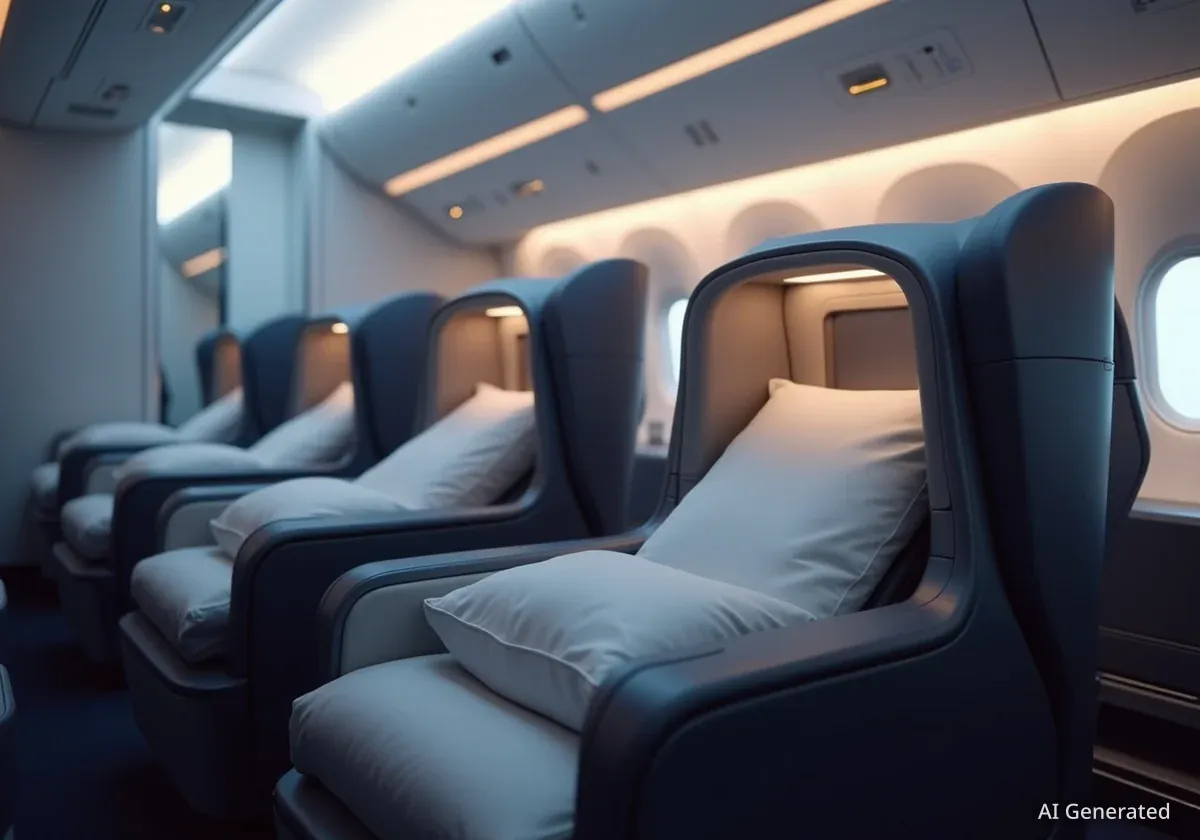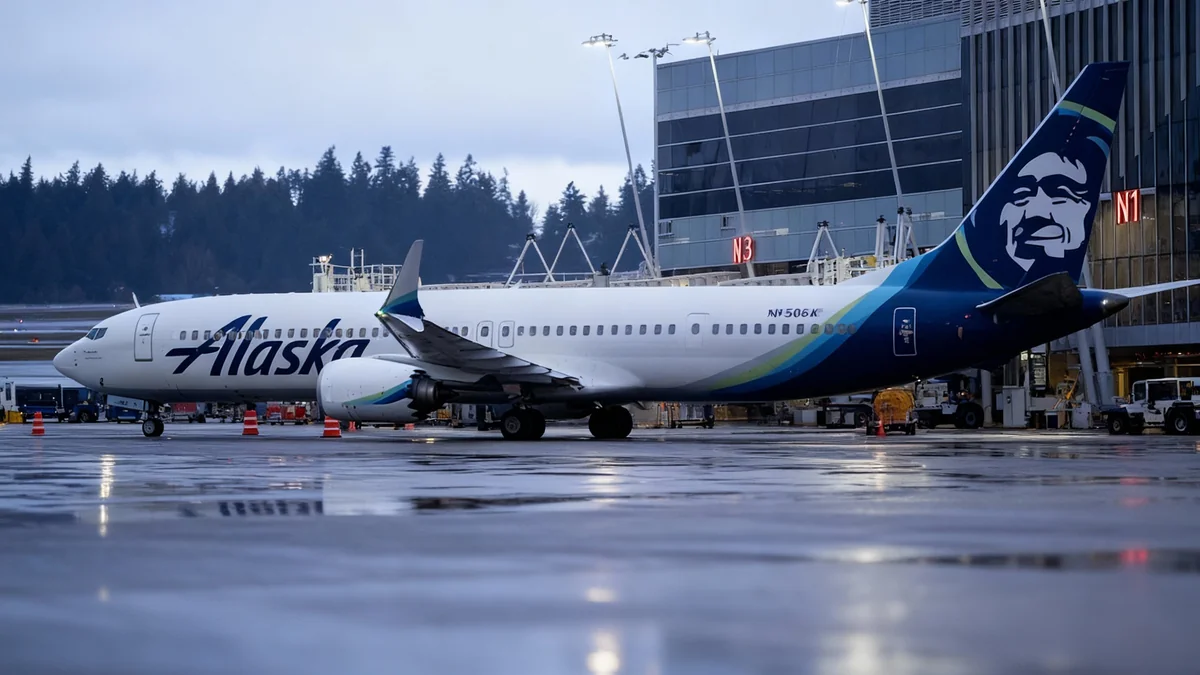Airbus has filed a new patent for a business class seat design that aims to deliver lie-flat comfort within a dense cabin layout. This development could significantly enhance premium travel options on both widebody and single-aisle aircraft, addressing a growing demand from airlines and passengers for improved inflight experiences.
The proposed seat unit features a unique design where the seat pan and backrest move together. A single motor powers this conversion from an upright sitting position to a fully flat bed. The design also includes a surrounding body with a rear partition, side panel, and sliding doors, creating a private mini-suite for passengers.
Key Takeaways
- Airbus patented a new business class seat for lie-flat comfort in dense cabins.
- The design features a single motor for seat movement and sliding doors for privacy.
- It can be deployed on both widebody and single-aisle aircraft, including the A321XLR.
- The patent aims to offer airlines pre-integrated, modular premium seating solutions.
- Improved density and direct aisle access are key benefits for airlines and passengers.
The Evolution of Premium Air Travel
The airline industry has seen a consistent rise in demand for premium travel options. This surge is driven by evolving passenger needs and the strong economic benefits for airlines. Travelers today prioritize rest, personal space, and convenience, especially on longer journeys. Many combine business and leisure trips, making comfort and sleep more valuable.
Hybrid work models also allow individuals to extend trips while remaining connected. This makes features like a larger seat, privacy, power outlets, and in-flight Wi-Fi essential productivity tools, rather than just luxuries. Families and older travelers are increasingly choosing premium cabins for a better overall experience.
Premium Cabin Growth
Premium cabins generate significantly more revenue per square foot compared to economy class. This allows airlines to achieve healthier margins, less affected by economic fluctuations.
Airlines Respond to Demand
Airlines have actively reconfigured their cabins to meet these changing demands. More business class suites now include doors for enhanced privacy. Premium economy offerings have also improved, providing a better experience than standard economy. Additionally, airport lounges and inflight catering services have seen upgrades.
These premium products are often easier to sell as small upgrades during booking or check-in. Loyalty programs, fueled by credit card points and status benefits, also channel substantial demand towards these options. Customers booking premium seats are typically less sensitive to price changes, providing airlines with more stable revenue on long-haul routes and at busy airports.
Manufacturers' Role in Premium Growth
Aircraft manufacturers play a crucial role in enabling this growth in premium travel. They design the aircraft and its operational economics, which airlines then utilize. Factors such as fuel efficiency, range, noise levels, cabin humidity, and cabin altitude are all engineered to enhance the passenger experience, especially on long flights.
Manufacturers are also responsible for engineering choices that directly influence cabin design. This includes cross-sections, door locations, seat-track spacing, and cooling capacity. They also determine the layout of lavatories and galleys, which helps airlines fit more premium suites into their aircraft.
Modern Cabin Standards
- Business Class: Lie-flat seating, direct aisle access, enhanced privacy.
- Premium Economy: Wider seats, more legroom, improved comfort compared to economy.
Beyond the physical structure, manufacturers curate the entire aircraft ecosystem. This involves integrating in-flight entertainment (IFE) systems, Wi-Fi connectivity, lighting, and galleys to offer a complete line-fit solution for airlines. They also work with regulators on certification for crashworthiness, flammability, and evacuation testing. Manufacturers provide retrofit kits and service bulletins, allowing older jets to be updated and refurbished during their operational lives.
"Manufacturers and cabin suppliers are not just responsible for building airplanes and seats but also for integrating space, systems, certification, and support in a way that allows airlines to profitably deploy more premium cabins and upgrade their offerings more quickly."
Operational Support and Supply
From an operational standpoint, manufacturers help incorporate digital tools that improve on-time reliability, a critical factor for high-paying customers. They also develop materials and designs that save weight. This allows airlines to install heavier premium interiors while still meeting their emissions targets. Furthermore, manufacturers influence supply through the availability of widebody delivery slots and coordinated supplier ramp-ups, which helps keep capacity tight and pricing stable.
Airbus's Strategic Patent Filing
Airbus likely filed this patent to secure a modular business class suite architecture. This design could be easily deployed across both widebody and narrowbody aircraft models. The core concepts of this new design address several key challenges in premium cabin layouts.
These challenges include optimizing the space between the cabin sidewall and the console, simplifying seat movement with a single-motor mechanism, and enhancing privacy with sliding doors. An armrest and ottoman combine to form a full bed, resolving issues related to cabin width, weight, and certification complexities.
Protecting these specific geometries and mechanisms gives Airbus a competitive advantage. It provides leverage over seat manufacturers and other competitors. This allows Airbus to offer pre-integrated line-fit options that airlines can implement at scale with minimal risk, weight, and cost. This approach also increases premium density, offering more suites without making the cabin feel cramped. It also enables higher yields on long-thin routes and brings true lie-flat seating to single-aisle aircraft, which is a key selling point for models like the Airbus A321XLR.
Technical Advantages and Future Proofing
From a technical perspective, this patent drives ongoing improvements in seat crashworthiness, wiring, and maintenance. These advancements directly support airlines' reliability targets. These patents also serve as a valuable negotiating tool for airlines when working with major aircraft manufacturers. They can reduce the time needed to certify future cabin layouts and gain approval for retrofits.
Features of the New Airbus Seat
The patented passenger seat has a smart, parallelogram-shaped footprint. It maintains a fixed side-to-console gap, allowing it to fit comfortably in both long-haul widebodies and single-aisle aircraft without feeling restricted. A tall side panel and a sliding door create a mini-suite effect. This design also helps keep the cabin's outer walls straight, enabling efficient, dense layouts. This flexibility allows airlines to easily adjust premium capacity based on market demand.
The use of a single motor for all seat movements, including the backrest and seat cushion, reduces overall weight. This is because fewer heavy motors are needed. It also improves wiring and lowers the number of potential failure points. Airbus's patent filing indicates that the design can be modified to accept additional motors if required.
The flat sleeping surface is created by extending a console side, a drop-down armrest, and the seat's ottoman. This forms a functional sleeping area that feels complete but not overcrowded. This seating arrangement can be adapted for most cabin types. Passengers can sit in herringbone pairs, or the design can be placed in single-aisle cabins with one seat on each side. Orienting every passenger to face away from the aisle offers superior privacy and improved direct aisle access. Hidden mechanisms and refined geometry enhance both the safety and aesthetic appeal of this seat.
Airline Appeal and Market Impact
Airlines currently invest significant resources in collaborating with cabin design partners to find optimal seating styles. These designs must meet multiple objectives despite complex operational limitations. The new Airbus seat addresses a primary need: offering passengers the features they demand in premium cabins.
Passengers today expect lie-flat beds and direct aisle access. Couples traveling long-haul also seek the ability to sit together comfortably. Given the high premium fares charged, passengers are generally unwilling to compromise on these comfort features.
Beyond passenger demand, the simplicity of having a standard design from Airbus is highly valuable to airlines. A pre-certified, modular solution that meets operator requirements can offer Airbus a significant competitive advantage when securing aircraft orders. This helps airlines avoid complex engineering challenges that can arise when heavy premium seats shift the aircraft's weight forward, potentially causing operational complications.
Ultimately, Airbus aims to position itself as a trusted partner for airlines looking to expand their premium capacity. This new business class seat is a key part of that strategy, offering a practical solution to meet evolving market demands.





